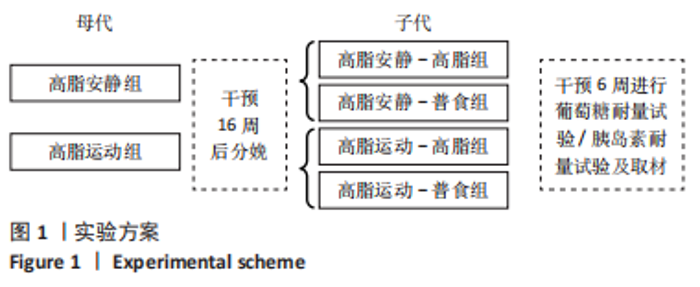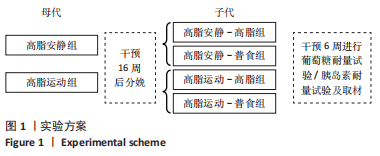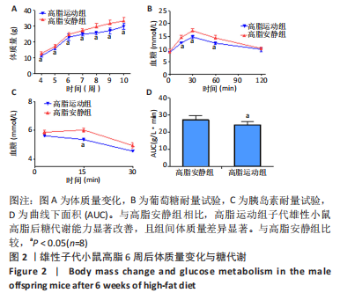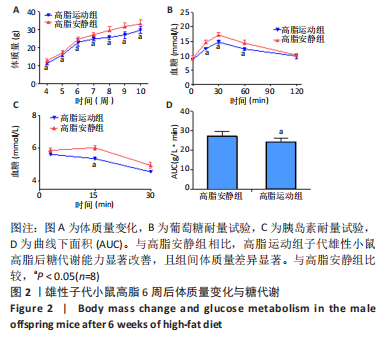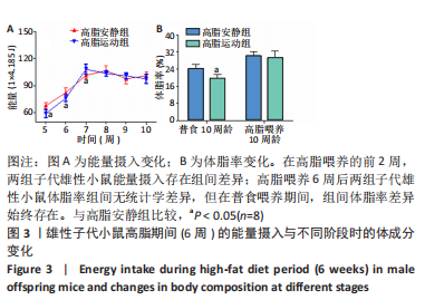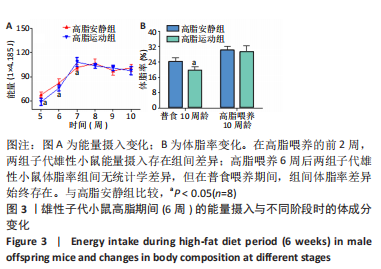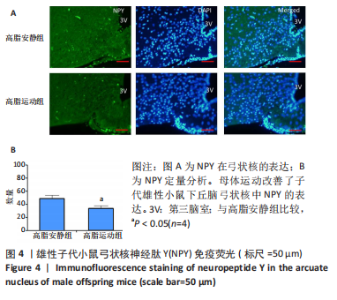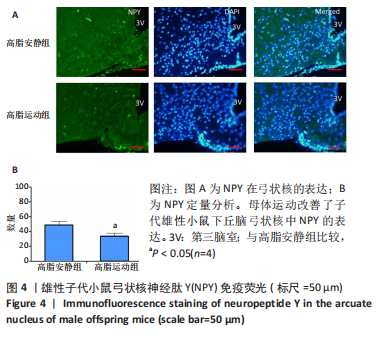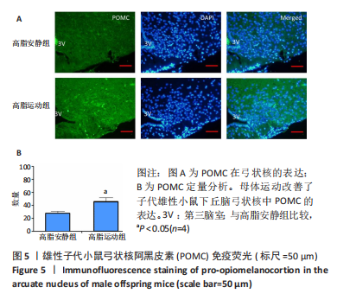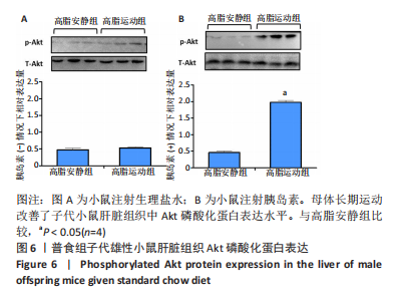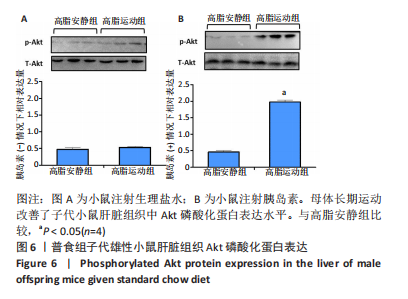Chinese Journal of Tissue Engineering Research ›› 2024, Vol. 28 ›› Issue (4): 556-561.doi: 10.12307/2023.986
Previous Articles Next Articles
Effects of maternal high-fat diet and exercise intervention on insulin sensitivity and the hypothalamic arcuate nucleus in male offspring mice
Zhu Xiaofeng1, Chen Weiwei1, Huang Jian2
- 1Jiaxing University, Jiaxing 314000, Zhejiang Province, China; 2Chongqing Three Gorges University, Chongqing 404020, China
-
Received:2022-12-27Accepted:2023-02-04Online:2024-02-08Published:2023-07-14 -
About author:Zhu Xiaofeng, PhD, Associate professor, Jiaxing University, Jiaxing 314000, Zhejiang Province, China -
Supported by:the Humanistic and Social Science Research Foundation for the Youth of the Ministry of Education, No. 20YJCZH253 (to ZXF); Humanities and Social Sciences Research Project of Chongqing Municipal Education Commission, No. 21SKGH204 (to HJ)
CLC Number:
Cite this article
Zhu Xiaofeng, Chen Weiwei, Huang Jian. Effects of maternal high-fat diet and exercise intervention on insulin sensitivity and the hypothalamic arcuate nucleus in male offspring mice[J]. Chinese Journal of Tissue Engineering Research, 2024, 28(4): 556-561.
share this article
Add to citation manager EndNote|Reference Manager|ProCite|BibTeX|RefWorks
| [1] BARKER DJP. The developmental origins of insulin resistance. Horm res. 2005;64 (Suppl 3):2-7. [2] DRAKE AJ, REYNOLDS RM. Impact of maternal obesity on offspring obesity and cardiometabolic disease risk. Reproduction. 2010;140(3): 387-398. [3] ZHU XF, YUN M, QUN Y, et al. Effects of high-fat diet and exercise intervention on the metabolism regulation of infant mice. Biomed Res Int. 2020;2020:2358391. [4] ZHU XF, FU S, MA Y, et al. Long-term exercise improves metabolism during pregnancy in high-fat fed mice. Int J Clin Exp Med. 2019;12(6): 6828-6840. [5] RAIPURIA M, BAHARI H, MORRIS MJ. Effects of maternal diet and exercise during pregnancy on glucose metabolism in skeletal muscle and fat of weanling rats. PloS One. 2015;10(4):e0120980. [6] VEGA CC, REYES-CASTRO LA, BAUTISTA CJ, et al. Exercise in obese female rats has beneficial effects on maternal and male and female offspring metabolism. Int J Obes (Lond). 2015;39(4):712-719. [7] KLEIN MO, MACKAY H, EDWARDS A, et al. Pomc and npy mrna expression during development is increased in rat offspring brain from mothers fed with a high fat diet. Int J Dev Neurosci. 2018;(64):14-20. [8] LAING BT, DO K, MATSUBARA T, et al. Voluntary exercise improves hypothalamic and metabolic function in obese mice. J Endoc. 2016; 229(2):109-122. [9] WU Z, XI P, ZHANG Y, et al. Lkb1 up-regulation inhibits hypothalamic inflamma-tion and attenuates diet-induced obesity in mice. Metabolism. 2021;116 (10): 154694. [10] KOCH M, VARELA L, KIM JG, et al. Hypothalamic pomc neurons promote cannabinoid-induced feeding. Nature. 2015;519(7541):45-50. [11] CQA B, XF C, DCA B. Pomc neurons dysfunction in diet-induced metabolic disease: Hallmark or mechanism of disease? Neuroscience. 2020;447:3-14. [12] STUEBE AM, OKEN E, GILLMAN MW. Associations of diet and physical activity during pregnancy with risk for excessive gestational weight gain. Am J Obstet Gynecol. 2009;201(1):51-58. [13] GENEST DS, FALCAO S, MICHEL C, et al. Exercise training promotes placental growth and development in an animal model of preeclampsia superimposed on chronic hypertension. Pregnancy hypertension. 2012;2(3):209-210. [14] UEDA M, ADACHI Y, TANAKA M, et al. Association between mental health and physical activity during pregnancy. Maternal Health. 2012; 53(2):367-374. [15] YOSHIFUMI T, DAISUKE A, KAZUSHIGE G, et al. High-intensity exercise causes greater irisin response compared with low-intensity exercise under similar energy consumption. Tohoku J Exp Med. 2014;233(2): 135-140. [16] LAING BT, DO K, MATSUBARA T, et al.Voluntary exercise improves hypothalamic and metabolic function in obese mice. J Endocrinol. 2016;229(2):109-122. [17] WASINSKI F, BACURAU RF, ESTRELA GR, et al. Exercise during pregnancy protects adult mouse offspring from diet-induced obesity. Nutr Metab (Lond). 2015;12:56. [18] CARTER LG, NGO TENLEP SY, WOOLLETT LA, et al. Exercise improves glucose disposal and insulin signaling in pregnant mice fed a high fat diet. J Diabetes Metab. 2015;6(12):634. [19] BARKER DJP, GLUCKMAN PD, GODFREY KM, et al. Fetal nutrition and cardiovascular disease in adult life. Lancet. 1993;341(8850):938-941. [20] NG SF, LIN RC, LAYBUTT DR, et al. Chronic high-fat diet in fathers programs beta-cell dysfunction in female rat offspring. Nature. 2010; 467(7318):963-966. [21] FRANKE K, HARDER T, AERTS L, et al. Programming’ of orexigenic and anorexigenic hypothalamic neurons in offspring of treated and untreated diabetic mother rats. Brain Res. 2005;1031(2):276-283. [22] SAFTLAS AF, LOGSDEN-SACKETT N, WANG W, et al. Work, leisure-time physical activity, and risk of preeclampsia and gestational hypertension. Am J Epidemiol. 2004;160(8):758-765. [23] ZHENG X, NIU S. Leptin-induced basal Akt phosphorylation and its implication in exercise-mediated improvement of insulin sensitivity. Biochem Biophys Res Commun. 2018;496(1):37-43. [24] HAJDUCH E, LITHERLAND GJ, HUNDA HS. Protein kinase B (PKB/Akt) — a key regulator of glucose transport? FEBS Lett. 2001;492(3):199-203. [25] VENDRELL J, BROCH M, VILARRASA N, et al. Resistin, adiponectin, ghrelin, leptin, and proinflammatory cytokines: Relationships in obesity. Obes Res. 2012;12(6):962-971. [26] EGGER G. Dousing our inflammatory environment(s): Is personal carbon trading an option for reducing obesity--and climate change? Obes Rev. 2010;9(5):456-463. [27] TESSIER DR, FERRARO ZM, GRUSLIN A. Role of leptin in pregnancy: Consequences of maternal obesity. Placenta. 2013;34(3):205-211. [28] GHERLAN I, VLADOIU S, ALEXIU F, et al. Adipocytokine profile and insulin resistance in childhood obesity. J Clin Med. 2012;7(3):205-213. [29] TAMORI Y, KASUGA M. Obesity and insulin resistance. Nihon Rinsho. 2009;67(2):236-244. [30] BIENSO RS, RINGHOLM S, KIILERICH K, et al. Glut4 and glycogen synthase are key players in bed rest-induced insulin resistance. Diabetes. 2012;61(5):1090-1099. [31] SUN B, LIANG NC, EWALD ER, et al. Early postweaning exercise improves central leptin sensitivity in offspring of rat dams fed high-fat diet during pregnancy and lactation. Am J Physiol Regul Integr Comp Physiol. 2013;305(9 ):1076-1084. [32] OKOROKOV PL, KALININ AL, STREBKOVA NA, et al. Comparative assessment of energy metabolism, body composition and metabolic features in children with hypothalamic and simple obesity. Obes Metab. 2020;17(3):249-256. [33] GALI RAMAMOORTHY T, ALLEN TJ, DAVIES A, et al. Maternal overnutrition programs epigenetic changes in the regulatory regions of hypothalamic pomc in the offspring of rats. Int J Obes (Lond). 2018;42(8):1431-1444. [34] KANG KS, YAHASHI S, MATSUDA K. Central and peripheral effects of ghrelin on energy balance, food intake and lipid metabolism in teleost fish. Peptides. 2011;32(11):2242-2247. [35] VAN DEN TOP M, LYONS DJ, LEE K, et al. Pharmacological and molecular characterization of atp-sensitive k(+) conductances in cart and npy/agrp expressing neurons of the hypothalamic arcuate nucleus. Neuroscience. 2007;144(3):815-824. [36] SHARMA A, JAYASENA CN, DHILLO WS. Regulation of the Hypothalamic-Pituitary-Testicular Axis: Pathophysiology of Hypogonadism. Endocrin Metab Clin. 2022;51(1):29-45. [37] MICHLEWSKA MO. The contribution of astrocytes to obesity-associated metabolic disturbances. J Biomed Res. 2022;36(5):299-311. [38] PAPAZOGLOU I, LEE JH, CUI ZZ, et al. A distinct hypothalamus-to-β cell circuit modulates insulin secretion. Cell Metab. 2022;34(2):285-98. [39] ZHANG ZY, DODD GT, TIGANIS T. Protein tyrosine phosphatases in hypothalamic insulin and leptin signaling. Trends Pharmacol Sci. 2015; 36(10):661-674. [40] ZHENG J, XIAO X, ZHANG Q, et al. Maternal and post-weaning high-fat, high-sucrose diet modulates glucose homeostasis and hypothalamic pomc promoter methylation in mouse offspring. Metab brain dis. 2015;30(5):1129-1137. |
| [1] | Ruan Ling, Wang Guanghua, Wu Rongping, Jin Zhan, Lyu Zhenqing, Zhang Nan, Li Shoubang. Correlation between exercise intensity and lipid metabolism disorder and oxidative stress in a high-diet rat model [J]. Chinese Journal of Tissue Engineering Research, 2023, 27(8): 1149-1155. |
| [2] | Bai Xing, Wang Guojun, Wang Shaokun. Improvement of cognitive function by blood flow restriction training: mechanisms and applications [J]. Chinese Journal of Tissue Engineering Research, 2023, 27(28): 4577-4585. |
| [3] | Xiao Zhe, Zhou Shufeng, Zhu Huan, Li Feng, Hu Jiangping. Changes in microvascular reactivity and exercise intervention in obese patients [J]. Chinese Journal of Tissue Engineering Research, 2023, 27(26): 4223-4230. |
| [4] | Ding Linlin, Lu Taotao, Wei Wei, Li Yongxu, Lin Libin, Lin Zhicheng, Xue Xiehua. Mechanisms by which swimming exercise and diet control improve hypothalamic lesions in APOE-/- mice with high-fat diet [J]. Chinese Journal of Tissue Engineering Research, 2023, 27(20): 3136-3142. |
| [5] | Chen Chichi, Zhang Yu, He Jiachen, Shi Qin. Osteogenic differentiation of bone marrow mesenchymal stem cells in obese mice [J]. Chinese Journal of Tissue Engineering Research, 2022, 26(24): 3846-3851. |
| [6] | Han Xuke, Chen Yiding, Chen Huizhen, Yang Xiaomei, Hong Peipei, Chen Qiu. Establishment and evaluation of neurogenic bladder model in rats with type 2 diabetes mellitus [J]. Chinese Journal of Tissue Engineering Research, 2022, 26(17): 2713-2719. |
| [7] | Xu Jie, Zhou Wenqi, Luo Xiaobing. Visual analysis of patellofemoral pain syndrome research hotspots and content [J]. Chinese Journal of Tissue Engineering Research, 2022, 26(12): 1877-1887. |
| [8] | Chen Zegang, Ding Haili, Li Long, Wang Chun. Changes of bone metabolism after different intensity endurance exercises in growing rats [J]. Chinese Journal of Tissue Engineering Research, 2020, 24(35): 5582-5588. |
| [9] |
Li Ying, Lin Wentao, Weng Xiquan.
Effects of different exercise intensities on visfatin level and glucose metabolism in type 2 diabetic rats [J]. Chinese Journal of Tissue Engineering Research, 2020, 24(26): 4196-4200. |
| [10] | Zhao Jianfeng, Geng Yu, Chen Qianbo, Yang Jinghui, Li Yan. Changes in insulin resistance and inflammatory factors in cataract patients with glaucoma after phacoemulsification and trabeculectomy: a self-controlled trial [J]. Chinese Journal of Tissue Engineering Research, 2020, 24(11): 1750-1755. |
| [11] | Liu Dongqi1, Li Rongmei1, Zhang Meiqi1,Chen Yanyan1, Zhang Haiping2 . Meta-analysis of the effect of aerobic exercise on mild cognitive impairment in the elderly [J]. Chinese Journal of Tissue Engineering Research, 2019, 23(35): 5727-5731. |
| [12] | Zhao Dalin1, Li Jing1, Ma Tie1, Gao Haining1, Liu Haopeng1, Zhang Shicheng1, Xu Sitong1, Xiao Jiayu1, Li Yiran1, Yan Shengnan1, Chang Bo1, 2. Changes of phosphoinositide 3-kinase-protein kinase B signaling pathway in skeletal muscle of type 2 diabetes rat models after 8-week aerobic exercise [J]. Chinese Journal of Tissue Engineering Research, 2019, 23(23): 3660-3666. |
| [13] | Qin Jun-jun1, Yin Dong1, Pei Guo-xian2, Jiang Shan3, Chen Si-yuan4, Wang Le5, Mu Tian-wang6, Li Ming-dong7 . Tissue-engineered bone with vascular bundles or sensory nerve tracts for repairing large bone defects [J]. Chinese Journal of Tissue Engineering Research, 2017, 21(8): 1161-1166. |
| [14] | Wang Ji-hong, Liu Xiao-dan, Hu Jun, Liu Jing-xin . Effects of Tai Chi exercise on lung function and exercise endurance of old patients with chronic obstructive pulmonary disease: a Meta-analysis [J]. Chinese Journal of Tissue Engineering Research, 2015, 19(5): 815-820. |
| [15] | Gao Yan, Wang Qing-shan . Effect of neuropeptides on periodontium and oral bone repair [J]. Chinese Journal of Tissue Engineering Research, 2014, 18(11): 1780-1786. |
| Viewed | ||||||
|
Full text |
|
|||||
|
Abstract |
|
|||||
